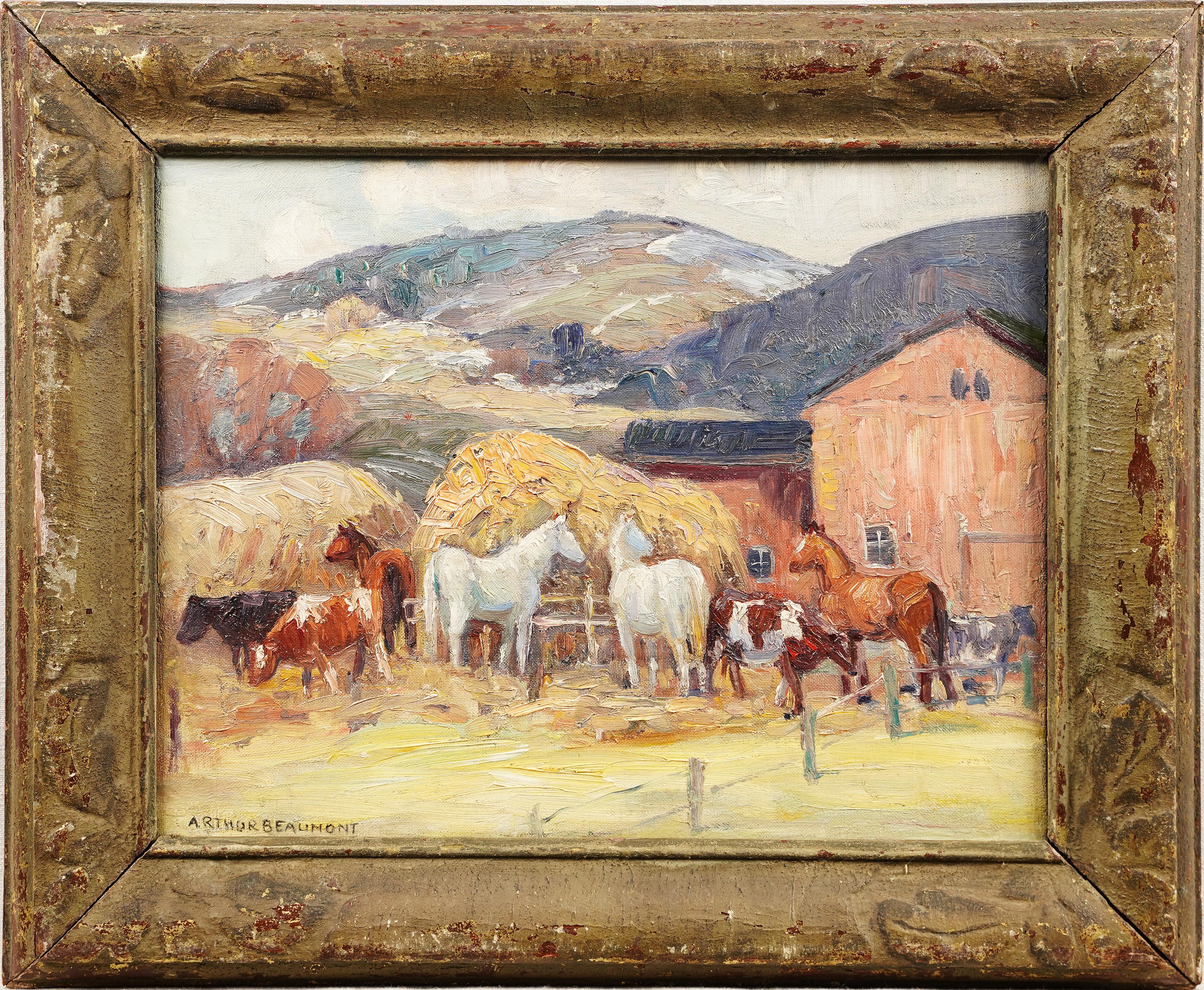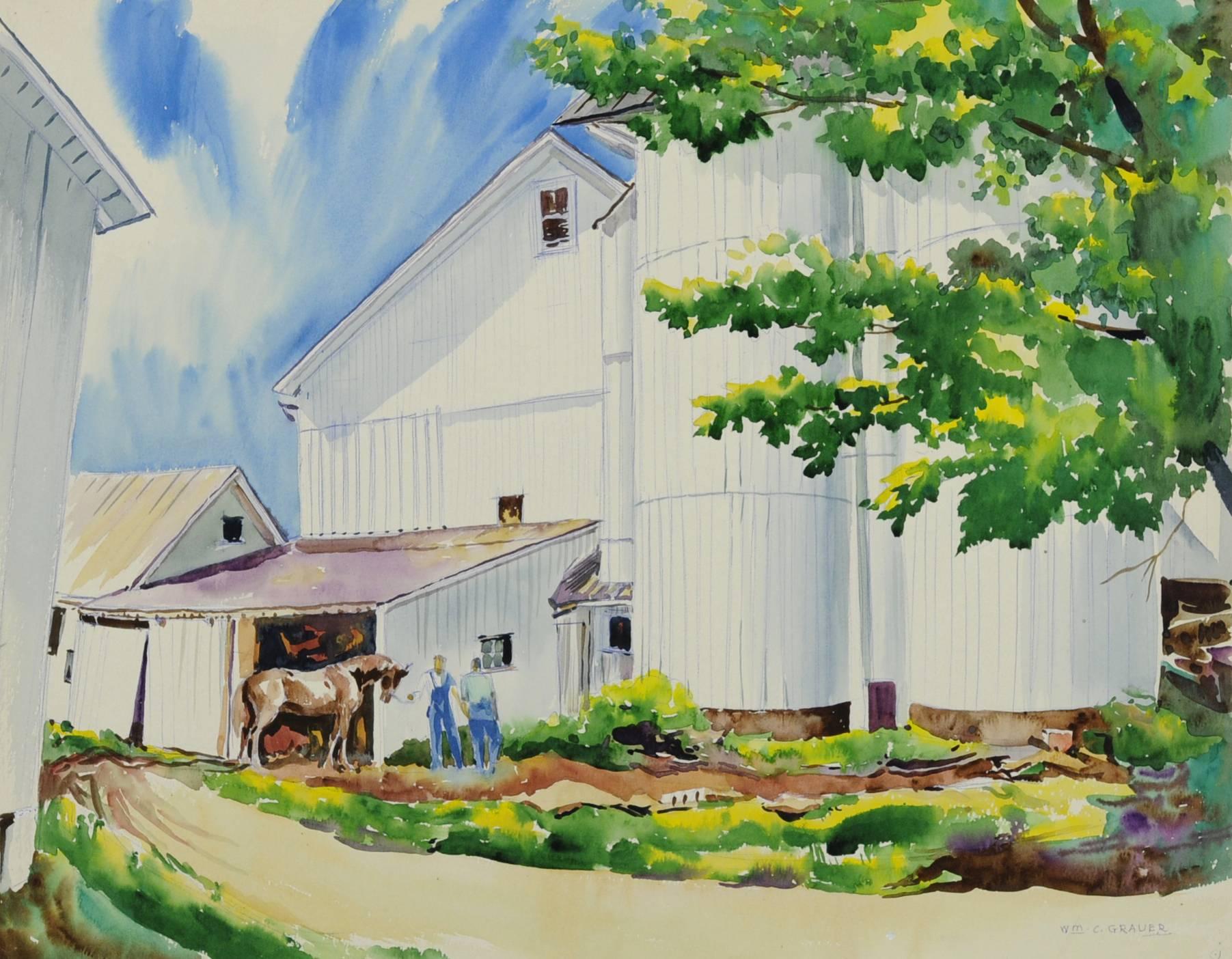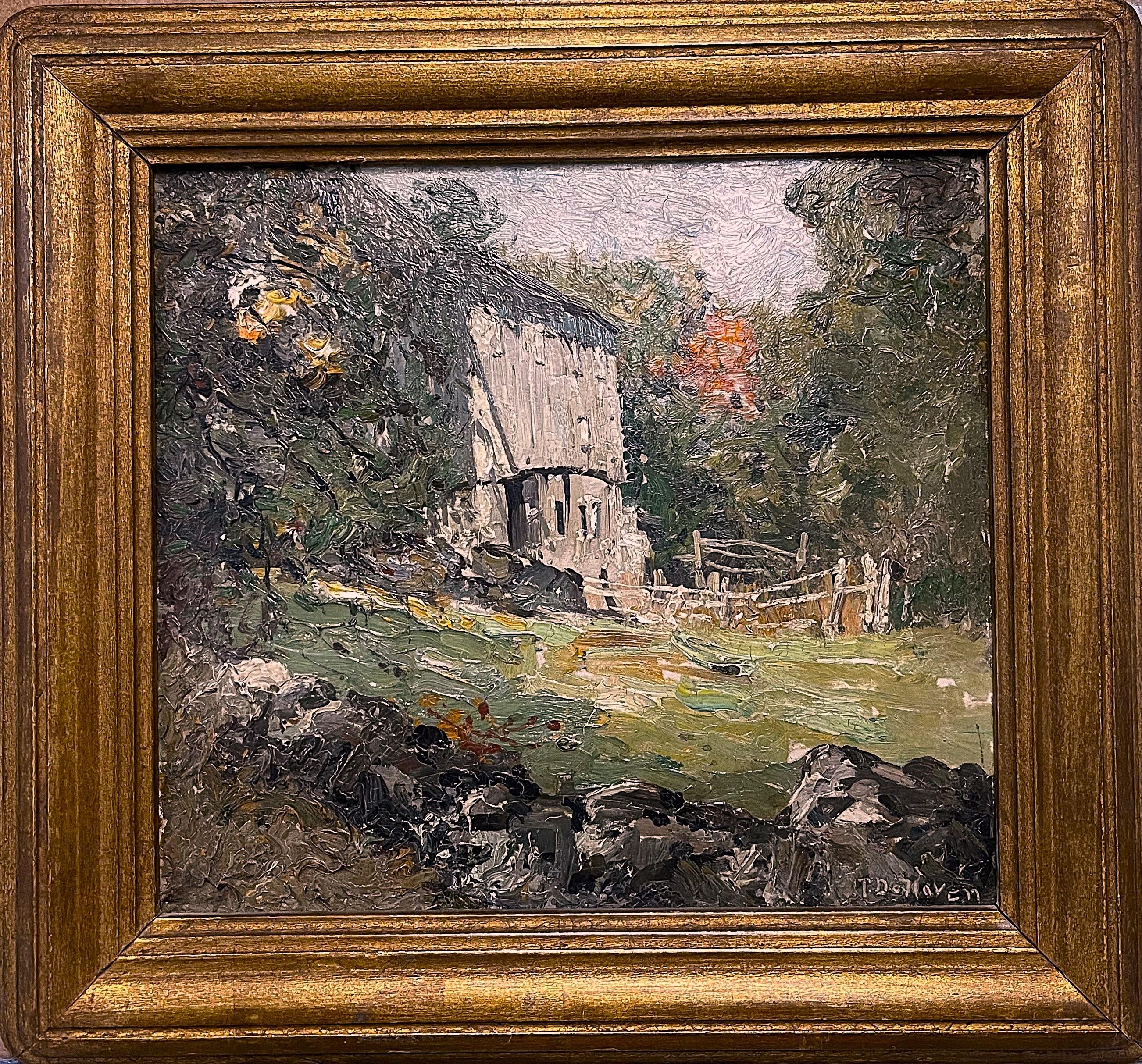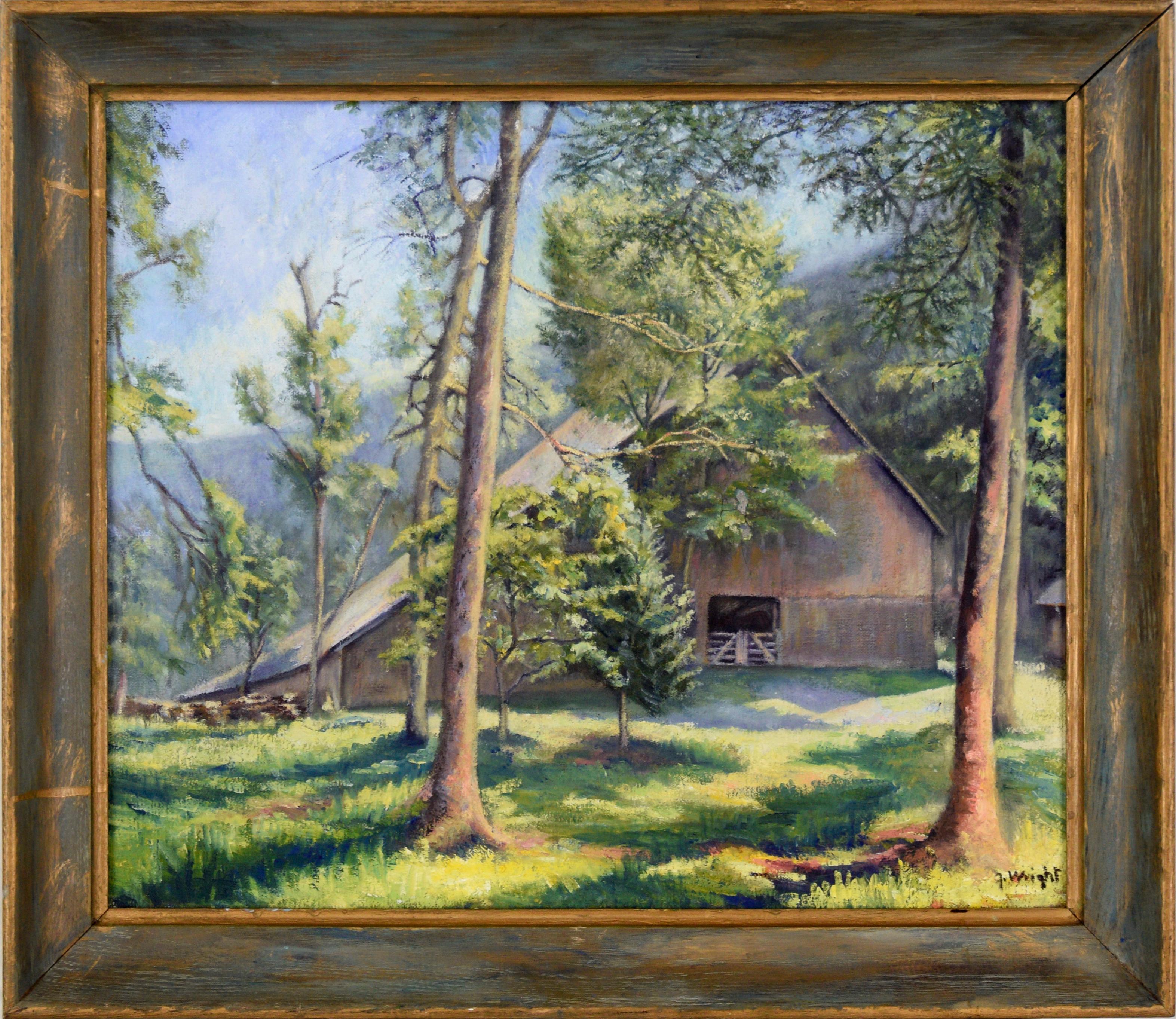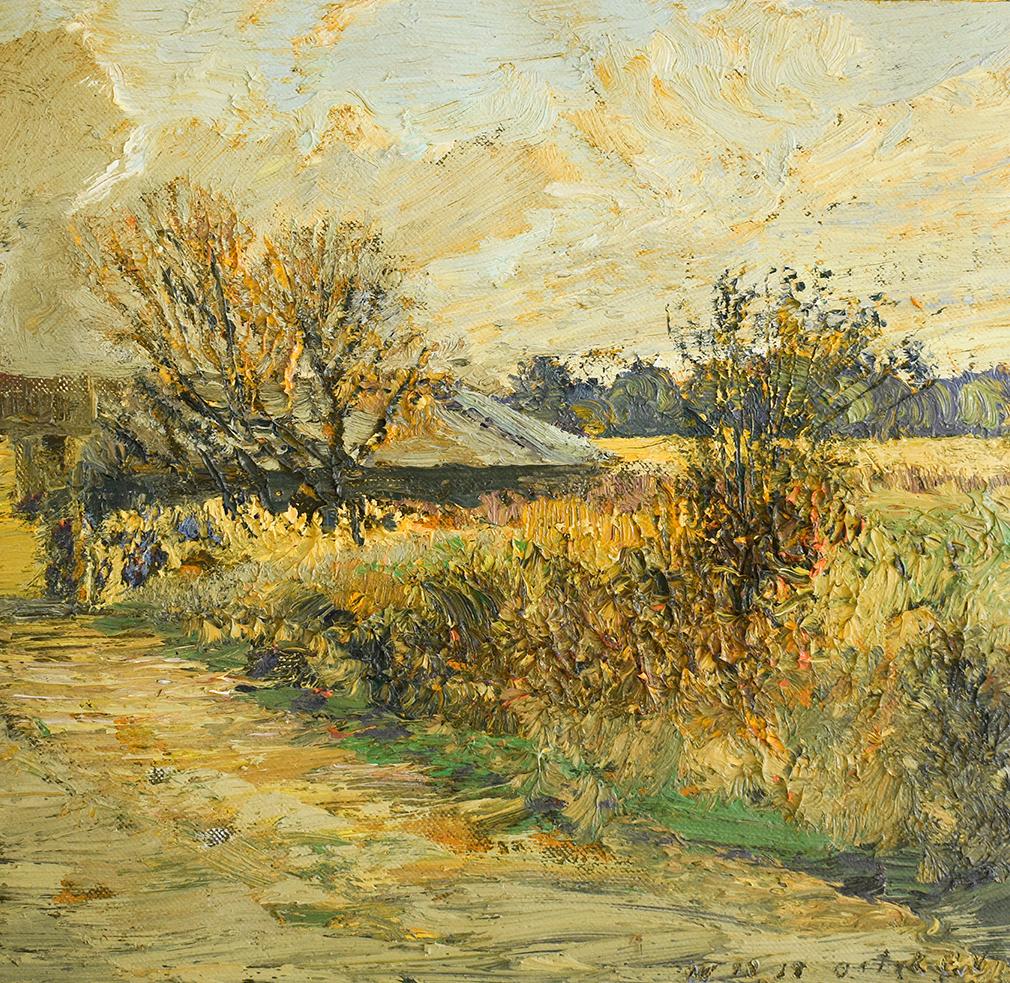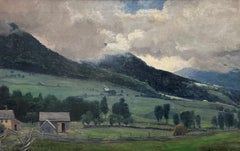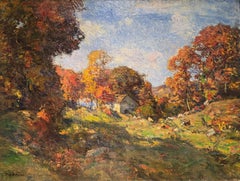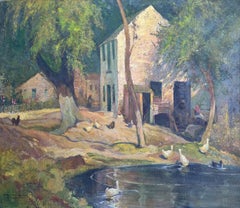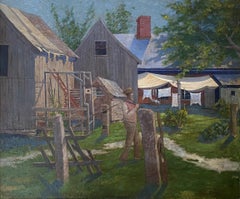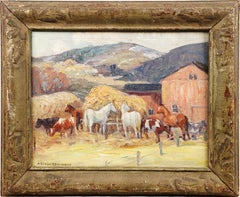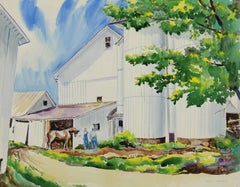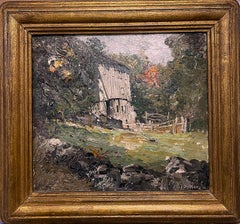Items Similar to "White Horse" Frederick Lester Sexton, Bucolic Barn, Farm Scene, White Horse
Want more images or videos?
Request additional images or videos from the seller
1 of 10
Frederick Lester Sexton"White Horse" Frederick Lester Sexton, Bucolic Barn, Farm Scene, White Horsecirca 1930s
circa 1930s
$9,600
£7,249.04
€8,353.72
CA$13,549.68
A$14,938.21
CHF 7,815.19
MX$183,264.13
NOK 98,377.78
SEK 91,998.78
DKK 62,385.81
About the Item
Frederick Lester Sexton
White Horse
Signed lower right
Oil on canvas
25 x 30 inches
Provenance
Part of a Collection received from the Lyme Art Association.
Frederick Lester Sexton received a lot of reviews and exhibitions in the 1920s, 1930s, and 1940s, when he was at the height of his career. Because it captured the personal view of many people's wish to ignore national issues and simply live their lives in their homes, his work was favorably welcomed. The rise of modernist styles like Abstract Expressionism, which started to take over the American art scene in the 1950s, also contributed to Sexton's fall in popularity. As collectors and regular spectators discover once more that realism is a valid component of American art because it speaks directly and clearly to the beauty they perceive in their surroundings, many artists, like Sexton, are experiencing a renaissance.
Cheshire, Connecticut, was the birthplace of Frederick Sexton in 1889. His father, J. Frederick Sexton, was the Rector of St. Peter's Church in Cheshire and a well-known Episcopal clergyman. The mother, Mary Louise Lester, was an amateur painter and came from a pretty well-known Hartford family. Frederick was killed in an open-hearth fire when he was eighteen months old. His right hand was badly burned and was never to be opened again. The father kept the family together after his mother passed away when he was nineteen.
Sexton's mother taught him art, and he went to public schools in New Haven. He received the prestigious Winchester Prize for a year of study in Spain while attending the Yale School of Fine Art, where he studied under Augustus Tack and Sargent Kendall. In addition, he was awarded the John Weir Scholarship for independent study. He was twenty-eight years old when he graduated in 1917, clearly older than the majority of his classmates. But to pay for his schooling, he had taken on a variety of jobs, including teaching woodworking in the public schools of New Haven. He fell in love with Dorothy Joyce, his future wife, who was equally devoted to the Episcopalian Church as he was.
Sexton received praise for his efficient job as an ambulance driver in France during World War I. He traveled extensively over Europe and was impacted by the numerous paintings he viewed in galleries and museums, particularly Cezanne's modernist pieces.
When one of his works was displayed at the New Haven Paint and Clay Club in 1922, he gained his first notoriety as an artist. He became one of the Club's first active members after being invited to join. Additionally, he became actively involved with the Old Lyme Art Colony in Old Lyme, Connecticut, and started going there on a regular basis to paint in the late 1920s. Due to the Old Lyme Art Association's membership requirements of land ownership and residency for a specific number of weeks of the year, he was unable to join the Lyme Art Association despite his affiliation with its members.
He purchased land from Guy Wiggins because he wanted to join, started construction on a house in 1936, and was soon elected a member. When the restrictions were altered years later to allow artists who resided within 25 miles to become members, he became extremely irate.
Sexton was also involved in the Connecticut Academy of Fine Arts, a state-level organization and exhibitor that aimed to foster collaboration between all of the state's art associations. Sexton was also elected to the Salmagundi Club in New York.
- Creator:Frederick Lester Sexton (1889-1975, American)
- Creation Year:circa 1930s
- Dimensions:Height: 29 in (73.66 cm)Width: 34 in (86.36 cm)
- More Editions & Sizes:Unique workPrice: $9,600
- Medium:
- Movement & Style:
- Period:
- Condition:
- Gallery Location:New York, NY
- Reference Number:1stDibs: LU1841216085312
About the Seller
5.0
Platinum Seller
Premium sellers with a 4.7+ rating and 24-hour response times
Established in 2022
1stDibs seller since 2022
120 sales on 1stDibs
Typical response time: <1 hour
- ShippingRetrieving quote...Shipping from: New York, NY
- Return Policy
Authenticity Guarantee
In the unlikely event there’s an issue with an item’s authenticity, contact us within 1 year for a full refund. DetailsMoney-Back Guarantee
If your item is not as described, is damaged in transit, or does not arrive, contact us within 7 days for a full refund. Details24-Hour Cancellation
You have a 24-hour grace period in which to reconsider your purchase, with no questions asked.Vetted Professional Sellers
Our world-class sellers must adhere to strict standards for service and quality, maintaining the integrity of our listings.Price-Match Guarantee
If you find that a seller listed the same item for a lower price elsewhere, we’ll match it.Trusted Global Delivery
Our best-in-class carrier network provides specialized shipping options worldwide, including custom delivery.More From This Seller
View All"Hillside Landscape" Edwin Child, Farmland, Vast Rural Mountainous Landscape
Located in New York, NY
Edwin Child
Hillside Landscape, 1896
Signed and dated lower right
Oil on canvas
18 x 28 inches
Edwin Burrage Child was a prominent New England portraitis...
Category
1890s American Impressionist Figurative Paintings
Materials
Canvas, Oil
"Autumn on the Farm" Charles Harold Davis, Fall Colors, Connecticut Hillscape
By Charles Harold Davis
Located in New York, NY
Charles Harold Davis
Autumn on the Farm, circa 1930s
Signed lower left
Oil on canvas
20 x 27 1/4 inches
Provenance
Private Collection, Florida
Charles Harold Davis was born in Ame...
Category
1910s American Impressionist Figurative Paintings
Materials
Canvas, Oil
"Frawg Hollow, Virginia" Corwin Knapp Linson, Southern Country Landscape
By Corwin Knapp Linson
Located in New York, NY
Corwin Knapp Linson
Frawg Hollow, West Virginia
Signed and titled lower left
Oil on canvas
24 x 28 inches
Provenance
The artist
Artist's family by descent
Corwin Knapp Linson was ...
Category
Early 1900s Academic Landscape Paintings
Materials
Oil, Canvas
"A Man in His Garden, " Emil Carlsen, Backyard and Barn Impressionist Landscape
By Emil Carlsen
Located in New York, NY
Soren Emil Carlsen (1848 - 1932)
A Man in His Garden, 1893
Oil on canvas
28 3/4 x 35 1/2 inches
Signed and dated lower right
Provenance:
The artist [1848-1932]
Macbeth Gallery, New York
Grand Central Art Galleries, New York
Luella May (Ruby) Carlsen (the artist's wife), New York
Dines Carlsen (the artist's son), Falls Village, Connecticut
Private Collection, Miami, Florida
Exhibited:
New York, Macbeth Gallery, Summer Exhibition: Painting by American Artists, July - August, 1926, no. 31 (as The Man in the Garden).
Houston, Texas, Museum of Fine Arts, Exhibition of Contemporary American Art by Members of the Grand Central Art Galleries, January 13 - 27, 1929 (as The Man in the Garden).
Miami Antique...
Category
1890s American Impressionist Landscape Paintings
Materials
Canvas, Oil
$48,000 Sale Price
20% Off
"Interior of a Stable" William Hart, Hudson River School Antique, Boy and Horse
By William Hart
Located in New York, NY
William M. Hart (1823 - 1894)
Interior of a Stable
Oil on canvas
17 x 12 inches
Provenance
William Macbeth Gallery, New York
Mrs. Mabel Brady Garvan Collection
Christie's New York, Sporting Art, November 28, 1995, Lot 116
Ann Carter Stonesifer, Maryland
Estate of above
Brunk Auctions, Asheville, North Carolina, January 27 2018, Lot 777
Exhibited
New York, The Metropolitan Museum of Art, Life in America, April 24 - October 29, 1939, no. 123, illustrated.
New York, Macbeth Gallery, 1892: Sixtieth Anniversary Exhibition, April 1952, p. 5, no. 18.
Literature
Turner Reuter Jr, Animal and Sporting Artists in America, Middleburg, Virginia, 2008, p. 306.
Gary Stiles, William Hart: Catalogue Raisonné and Artistic Biography, no. 1126, illustrated.
It should be noted that the Francis Patrick Garvan and Mrs. Mabel Brady Garvan collection, of which this painting was a part of, was one of the foremost American Art collections and now makes up a large part of the Smithsonian American Art Museum and the Yale University Art Gallery collections.
Born in 1823 in Paisley, Scotland, William Hart emigrated with his parents to the United States at the age of nine and settled in Albany, New York. It was here that Hart first began his artistic training when he was placed under the tutelage of Messrs, Eaton & Gilbert, the prestigious coach-makers from Troy, New York. During this time, Hart learned how to decorate coach panels, covering them with either landscapes or figurative compositions. At the age of seventeen, he was eagerly contemplating an artist’s profession. Consequently, he left the mechanical trade of coach-making and began expanding his artistic pursuits to more refined endeavors.
Hart followed coach-making with decorating window shades and later developed an interest in portraiture. Around 1840, he established his first formal studio in his father’s woodshed in Troy. There, he created many likenesses of individuals, affording him a nominal income. Once, he remarked that he felt prouder over his first fee of five dollars for painting a head then for the larger sums he would command later in his career. Nevertheless, his wages from portraits during this early period proved insufficient. Thus, he expanded into landscape painting, allowing him to barter his works or sell them for modest prices.
In 1842, Hart moved to Michigan in an attempt to further his success; portraiture remained his primary means of support. Unfortunately, his experiences in the West were disappointing. Hart spent three years living a rough existence until he finally returned to Albany in 1845. Upon his return, he fully devoted himself to the art of landscape painting. Despite his failing health, he worked diligently to perfect his skill until 1849 when he traveled abroad to his native land of Scotland. This trip was made possible through the generosity of his patron and advisor, Dr. Ormsby of Albany. For three years, he studied in the open-air, creating brilliant sketches of the Scottish Highlands and the surrounding British Isles.
Returning to Albany once more in 1852, Hart enjoyed improved health and was reinvigorated with purpose. The following year, he moved to New York and opened a studio, promoting himself as a specialist in landscape painting. Hart became a regular contributor to the National Academy of Design. His works received a great deal of attention from artists and connoisseurs alike, all of whom praised him for his fresh, self-taught style. In 1855, he was designated as an associate of the National Academy of Design; three years later he was elected to Academician. In 1865, he was unanimously chosen to be the first president of the Brooklyn Academy of Design. It was during his tenure there that he delivered his famous lecture The Field and Easel, which emphasized the distinguishing principles of landscape art in America. Hart argued that landscape painters should express the “look of the place” being depicted.Critics during the 1870s noted his sensitive balance between capturing a strict “real” interpretation of nature and that of a more “ideal” sentimental tone. For instance, in 1869, Putnam Magazine noted that Hart brought back “exquisite studies” of the surrounding Tappan...
Category
19th Century Hudson River School Animal Paintings
Materials
Canvas, Oil
$60,000 Sale Price
20% Off
"Meadow Landscape in Summer, " Harold Dunbar, Factory Scene, Impressionism
By Harold Dunbar
Located in New York, NY
Harold C. Dunbar (1882 - 1953)
Meadow Landscape in Summer, 1929
Oil on canvas
17 1/2 x 21 inches
Signed and dated lower left
Harold C. Dunbar — painter, teacher, writer, and illustrator — was born in Brockton, MA on December 8, 1882. He resided in Chatham, MA and died in 1953. His work includes portraits, landscapes, street scenes, still lifes, harbors and coastal scenes.
Dunbar studied with Ernest Lee Major (1864-1950) and Joseph De Camp...
Category
1920s American Impressionist Landscape Paintings
Materials
Canvas, Oil
You May Also Like
Landscape with Barn and Horse
By Elmer Frederick Ekeroth
Located in San Francisco, CA
This artwork "Landscape with Barn and Horse" c.1985 is an acrylic painting on canvas by noted California artist, Elmer Frederick Ekeroth, American,...
Category
Late 20th Century American Impressionist Landscape Paintings
Materials
Acrylic
Antique American Snowy New England Winter Horse Farm Landscape Oil Painting
Located in Buffalo, NY
Antique American impressionist seascape signed oil painting. Oil on canvas. Signed. Framed. Image size, 16L x 12H.
Artist Bio:
Arthur James Beaumont was born in Yorkshire, England in 1877. He studied with Julius Olsson in London before moving to Paris at the turn of the century. In Paris, Beaumont studied at the Academie Julian* with William Adolphe Bougereau. The Academie awarded him a gold medal in 1905.
After completing his studies, Beaumont settled in Cornwall where he became known for his marine and landscape scenes as a member of the St. Ives School*, an artist colony. While living in Cornwall, Beaumont traveled to the United States to exhibit his paintings. In 1906 he settled in New York, buying a house on Staten Island with his brother and sister in law, Ernest and Henrietta Beaumont, also artists, who arrived from England in 1907.
Although Arthur Beaumont...
Category
1890s Impressionist Landscape Paintings
Materials
Canvas, Oil
$1,996 Sale Price
20% Off
untitled (The White Barn with Farmers and Horse)
By William Grauer
Located in Fairlawn, OH
untitled (The White Barn with Farmers and Horse)
Watercolor, c. 1950
Signed by the artist in ink lower right: Wm. C. Grauer
Numbered in pencil verso: 152
Provenance:
Estate of the Ar...
Category
1950s American Realist Landscape Drawings and Watercolors
Materials
Watercolor
Franklin Dehaven, NA Oil Painting Salmagundi Artist Farm with Barn Sunny Day
By Franklin DeHaven
Located in Chesterfield, NJ
Sunny Afternoon, farm with barn
oil on panel. Image is 10 x 9 unframed and 13 3/4 x 12 3/4 x 1 framed.
Salmagundi Club label and bio verso plus 2 other labels as seen. One partial...
Category
Early 20th Century Impressionist Landscape Paintings
Materials
Oil
Horse Stables in the Valley - Farm Landscape
Located in Soquel, CA
Idyllic farm landscape by unknown artist F. Wright (20th Century). A large animal barn is nestled among lush trees, in a large valley. In the distance, a tree-covered hillside wraps ...
Category
Mid-20th Century American Impressionist Landscape Paintings
Materials
Canvas, Oil
$760 Sale Price
20% Off
#5715 Overgrown Barn: Impressionist En Plein Air Landscape Painting on Linen
By Harry Orlyk
Located in Hudson, NY
#5715 Overgrown Barn, 2019 by Harry Orlyk
(Impressionistic, en plein air autumn landscape of a sunlit barn in a field)
oil on linen mounted on homasote board, ready to hang as is
14.5 x 14.5 inches unframed
Signed lower right corner
Harry Orlyk is celebrated for his ability to capture rural country landscapes with impressionistic brushstrokes and bright color palettes. Painting daily, the artist drives throughout the upstate New York, stopping to observe and paint 'en plain air' whenever and wherever a landscape strikes him. Orlyk prefers to leave his canvases unframed to reveal the exposed linen which are nailed to sturdy homasote boards for easy installation. This painting is a perfect example of Orlyk's impressionistic aesthetic. Here, the artist captures a quaint country landscape in a range of warm, golden tones. Orlyk's signature use of soft yellows creates a gently luminous atmosphere. The scene is made with gestural strokes of paint that culminate onto a textured, impasto surface. The artist's signature is located in the lower right corner.
The artist prefers to leave his paintings unframed. The painting can be installed with one nail, hammered behind the linen and through the homasote board.
About the artist:
Harry Orlyk was born in Troy, New York in 1947. In 1971 after graduating college, he went on to graduate school at the University of Nebraska at Lincoln . Over the next nine years, he was influenced by several Nebraskan artists. "Still-life painter Robin Smith taught me how to use paint without turpentine - to paint from the tube." He also admits the influence of photographer Lawrence McFarland who taught him what spiritual space was, and how to emphasize it. Lastly he credits well-known Lincoln painter Keith Jacobshagen...
Category
2010s Impressionist Landscape Paintings
Materials
Linen, Oil, Board
More Ways To Browse
White Horse
Hand Painted Horse Painting
Horse Fire
French Farm House
Peter Clay
John Augustus
American Farm Art
Painter Augustus
Vintage Farm Scenes
Impressionist Farm Barn Painting
Bucolic Painting
White Barn
American Farm Oil Paintings
American Barn Paintings
Frederick J Brown
Vintage Ambulance
Frederick J Brown Painting
Used Horse Barn
